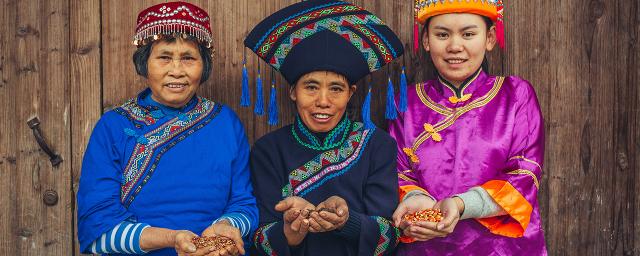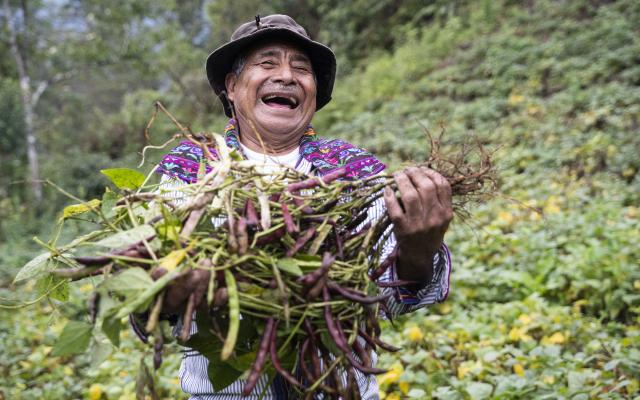
Members of Mashan Rongyan Farmers’ Cooperative proudly showing their seeds during the Covid-19 pandemic, Yunnan, China. Photo: Wenyan Wang/Farmers’ Seed Network.
Malnutrition remains one of the greatest global health challenges, and women and children are its most visible and vulnerable victims. Shortly after COVID-19 was declared a global pandemic, the 2020 Global Nutrition Report concluded that malnutrition is leading cause of deaths and ill health worldwide. Indeed, the global burden of disease is primarily diet-related, as the lack of healthy food items and nutrients appears to be a critical part of disease risk.
As asserted by The State of Food Security and Nutrition in the World 2020, three billion people cannot afford healthy diets. This implies that the world is not on track to meet its zero-hunger goals. The COVID-19 crisis has worsened food and nutrition insecurity, especially for poor smallholder farmers in rural areas of developing countries. They have less access to food and less income, while the prices of some foods that they used to buy to diversify their diets have gone up.
The solution is at hand
Food security cannot be achieved without access to adequate nutrition – in terms of protein, energy, vitamins and minerals – for all household members at all times. The wide diversity of existing food plants can contribute to reducing and even ending malnutrition and food scarcity by adding diversity and nutritional value to the diets of men, women and children.
In Asia, wild food plants have been documented as a key source of vitamins, minerals, secondary metabolites and essential oils. In Africa, indigenous greens have been termed ‘super vegetables’ for their potential to contribute to better nutrition. Latin America is home to ‘super fruits’ rich in vitamins and other important nutrients.
Food plant diversity on Earth
The plant kingdom hosts plenty of edible species with high potential to diversify our diets, address nutritional requirements and shortcomings, mitigate risks in agricultural production, and provide rural households with additional income through commercialization.
Despite their potential to contribute to coping with the food, health and climate crises, most are usually overlooked in research, markets and policies on food and agriculture. Unsustainable practices and climate change have also led to an increasing loss of biodiversity. People have used 7,000 known species of edible plants as food throughout human history. Nowadays, only 30 crops account for 95% of our energy intake – and only four (rice, wheat, maize and potato) cover 60% of our caloric needs.
Family farmers, who occupy around 70-80 percent of farmland and produce more than 80 percent of the world's food in value terms, hold most of the traditional knowledge associated with local food plants. Face with the Covid-19 crisis, some have started to realize that the answers are in the biodiversity of their surroundings. Edible local species offer a solution that is both healthy and affordable, given that they can be picked ‘for free’. They hold the key to building rural household resilience and food and nutrition security during the COVID-19 crisis. Farmers can act as a vanguard, assisting their communities in improving their diets.
Local food plants as a safety net
Local food plant diversity brought ease of mind for highland family farmers from Guangxi in Yunnan, China, during the COVID-19 pandemic, as indicated by Yufen Chuang and Xin Song from Farmers’ Seed Network. Lockdown reduced the supply of vegetables and meat from local markets, but family farmers did not face food shortages: they were able to be self-sufficient, ensuring good nutrition based on wild food plants and local crops like herba emiliae, goji berry, cassia tora and local tomatoes. They grow crops that are easy to store such as millet, maize, pumpkins, radishes, potatoes, carob beans and traditional legumes.

Jesus Ramírez is proud of his harvest of local beans, Todos Santos Cuchumatanes, Guatemala. Photo: Carlos Zaparolli/Oxfam
In the Terai region of Nepal, the lockdown restricted communities’ access to food from markets. Farmers responded by using more local plants – such as wheat, wild leafy vegetables, mushrooms, beans, pumpkins and jackfruit – according to Achyut Gaire, Saroj Pant and Rajendra Dhakal, from LI- BIRD and Oxfam in Nepal respectively. As explained by family farmer Neelam Chaudhary many women collected bihi (a wild medicinal vegetable from the forest) and taro, which used to be the tradition before they started to buy vegetables at the market. Gita Devi Chaudhary added: “During the lockdown the vegetable prices went up and there was a shortage of potatoes. We then used wild yam and taro to make curry. We also made masaura (dried mix of yam and taro) to store it for a longer period.”
In Guatemala, neglected and underutilized species are playing a key role in the daily diet of family farmers during the pandemic, as detailed by Reinaldo Mendoza from Chicoy Todos Santos Cuchumatán community to the staff of the Asociación de Organizaciones de los Cuchumatanes (ASOCUCH). Reinaldo indicated that gathering food plants which used to be regarded as ‘underutilized’ – such as hierba blanca, nabo, hierba mora, bledo and chunis – has become an important strategy in his community to cope with food scarcity. Nowadays, families consume these plants twice a day as part of their main meals, and they are increasingly aware of their nutritional value.
Farmers from Chirundu district in Zambia, such as Julius Mufana, have been coping with food scarcity by gathering more wild fruits including njiiyi, makunka, mang’ombyo, nchenje, tamarind and baobab fruit. Last year, the Community Technology Development Trust (CTDT) built community seed banks in Zambia to preserve the seeds of local food plants while working to revive the traditional knowledge and culture associated with them.
These examples clearly illustrate the important role that plant biodiversity and traditional knowledge can play in ensuring food and nutrition security for millions around the world. Local food plants have been functioning as a rural safety net during the pandemic, ensuring the resilience of family farmers while preserving biodiversity. These are roles they can play not only in times of crisis, but at all times, and this should be taken into account in national policy development and economic recovery measures.
Sowing Diversity = Harvesting Security global program
SD=HS work on local food plants for nutrition currently implemented by Oxfam and partner organizations in eight countries: Uganda, Zambia, Zimbabwe, Peru, Guatemala, Laos, Nepal and China. Using Farmer Field Schools and other participatory approaches, it aims to rescue and promote crop and food diversity and strengthen communities’ strategies to cope with seasonal cycles of food scarcity.
Our starting point is a community’s knowledge, cultural values, needs and priorities. We work with a gender approach, helping to strengthen the position of women and youth in households, communities and institutions.
By the end of 2020, we had established 234 Farmer Field Schools, reaching more than 5,300 smallholder farmers.